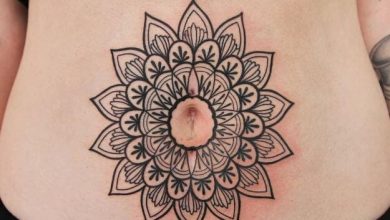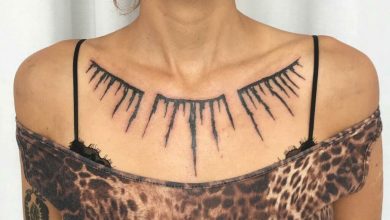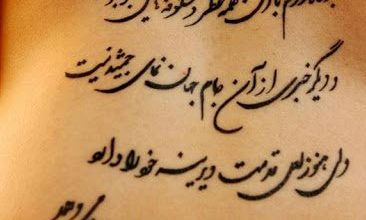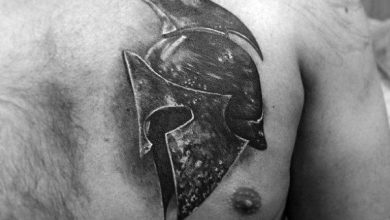Viking Tattoos: History of the Northmen • Tattoodo
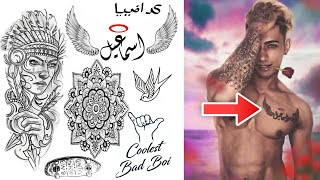
sailing the fjords, the men and women of the north were tough sailors, fierce fighters, and incredible craftsmen.
did they really have tattoos? it is a widely considered fact that the vikings and northmen in general were heavily tattooed.
however, historically, there is only one piece of evidence that mentions that they are actually covered in ink.
Did Vikings have tattoos?
so how do we know if they really had tattoos? The simple answer is that unless a discovery is made of an intact Viking, which includes skin from him, we’ll never know one way or the other.
There are clues, clues that can help us decide for ourselves if we believe these formidable adventurers were inked.
Our first and most important clue is the account of Ahmed Iban Fadlan in 921 AD. An Arab scholar, Fadlan was sent by the Caliphate to the Middle Volga, part of what is now Russia.
While there, he encountered a group of Northmen and it is here that we have our only account in history to say that they had some kind of decoration on their skin.
‘as tall as palm trees, blond and reddish, they don’t wear tunics or kaftans. every man wears a cloak with which he covers half of his body, so that one arm is uncovered. they carry axes, swords and daggers and always have them close at hand. they use Frankish swords with wide, fluted blades. they are dark from the tips of the toes to the neck: trees, pictures and the like.”
Historians seem to generally accept that this fadlan account would indicate that the Vikings were indeed tattooed.
Why are there no other accounts registered? the men and women of the north were not known for keeping written records of their history, most of what we know today is what was passed down orally, this not only means that much has been lost to history, but also what we have, much is impossible to translate.
Fear not, as we still have a few clues to explore.
Another Arab writer, al-tartushi, wrote that both northern men and women wore eye makeup, especially eyeliner.
This is important as it shows that people at this time were comfortable adorning their skin with markings. now these may have been temporary tattoos, rather than permanent.
There are references to faces being painted during rituals, either with blood or ashes to create a dark blue looking ink, again not permanent, but further evidence that the skin was marked in special ways.
p>
It’s still not an absolute confirmation though, is it?
the saami are a people who live in finland, sweden, norway and the kola peninsula. it is well established that their ancestors did, in fact, practice tattooing and also intermarried with the Northmen whom we refer to as Vikings.
Historians debate the meaning and origin of the word “Viking”, but the online etymology dictionary says the following: “The form Viking is attested in 1820, in jamieson’s notes to “the bruce”. The word is a revival of historians; it was not used in Middle English, but was reintroduced from Old Norse vikingr “freebooter, sea-rover, pirate, viking”, which it is usually explained with the correct meaning “one who came from the fjords”, from vik ‘stream, inlet, small bay'”.
in northern europe tattooing was a fairly common practice and in fact there have been numerous finds when burial sites were discovered and the skin was intact. Though there are no Northmen. It seems that farming and seafaring nations have been surrounded by tattoos throughout history.
However, what is most interesting is the fact that in AD 793, Viking ships made their way through the fjords and across the sea, eventually landing for the first time in England.
why is this so interesting? well, on the whole the Anglo-Saxons were very well known for tattooing themselves, using woad. This has been well documented by popes, various texts, and even by Gaius Julius Caesar in AD 55. c., stating that ‘all Britons dye their bodies’. with woad, which produces a blue color, and this makes them look more terrifying in battle.’
As stated above, in truth, there is no way to know for sure, but the evidence suggests that the Vikings were not only surrounded by people who tattooed themselves, but there are some references to them doing it themselves. and they were a highly creative people, regularly adorning the items they made with symbols of importance or runes.
so it’s not that much of a stretch to think that they actually tattooed themselves.
I came across an article saying that something resembling a tattoo needle and a stained bowl had been found in a Viking graveyard, although I can’t find it again, although it’s out there! Of course, this may have been a tool for staining material, wood, or whatever, but it’s interesting nonetheless.
if they did indeed have an obsession with ink, then what would they probably have covered themselves with?
intricate patterns, elaborate knots, animals and perhaps representations of the gods. much of the surviving artwork and carvings are highly reminiscent of Celtic and pagan designs.
These are some of the most likely options…
the most popular viking tattoos
yggdrasil tattoo
Looking at fadlan’s account, we have a good start in discovering this, “trees, images and the like”. trees is a very important mention and most likely these trees were representations of yggdrasil.
yggdrasil tattoos depict a huge ash tree, which is central to Norse mythology, connecting the nine worlds with each other. it was believed that the gods visited the tree regularly, that great mythical creatures resided within the tree, and that it was simply the center of their universe.
vegvisir tattoo
Hairing specifically from the Icelandic Vikings, the vegvisir, meaning “that which shows the way”, is a spiritual talisman that helps guide the wearer to the right path, safe from bad weather.
a vegvisir tattoo is a favorite of many icelanders including bjork who has one.
however, it is interesting to note that this is “a symbol described only in a modern Icelandic collection of spells, the so-called huld manuscript. that book has nothing more than this sentence to say about it: “if this one gets the sign, one will never get lost in storms or bad weather, even when one does not know the way.”
aegishjalmur tattoo
Also from the Icelandic Vikings, the Helm of Awe, as it is more commonly known, was a staff used for protection and to strike fear into enemies.
It looks a lot like the vegvisir, but I hope you can tell the subtle differences.
mjölnir or thor’s hammer tattoo
thor’s hammer, probably used to represent power and fear.
Thor’s hammer was so powerful it could topple mountains. there are many depictions of the hammer, but more modern versions omit much of the intricate knotwork that the Northmen were famous for carving.
This is possibly the most famous of all Viking tattoos due to its use in many movies, TV shows and books.
tattoo gallery: the 250 best Norse mythology tattoos of the year
triskelion tattoo
Odin’s triple horn, each named Óðrœrir, boðn, and són, is said to contain a mixture of blood, from kvasir, a man who supposedly could answer any question put to him, and honey.
is a symbol of wisdom. Said to be derived from the Greek word “triskeles” meaning “three legs,” the triskelion is actually seen in many different cultures, including Norse mythology.
As you can imagine, along with wisdom, a triskelion tattoo can be evolution, the life-death cycle, movement, action and progression.
shell tattoo
There is no definitive answer to what this symbol and Valknut tattoos represent, however the most commonly accepted definition has to do with life and death, with a dash of Odin thrown in for good measure.
“archaeologically, it appears on various runestones and pictorial memorial stones dating to the Viking Age and found on the Swedish island of Gotland, as well as on grave goods from the Oseberg ship burial in Norway.[1] its name is it is not mentioned in any contemporary sources, valknut is a modern Norwegian compound word meaning “knot of the fallen in battle” and was introduced by Norwegians who lived long after the Viking Age.[2] “
sun wheel tattoo
A controversial symbol, the sun wheel, commonly known as a swastika, traces its roots to many ancient civilizations, including Old Norse.
Actually, it is a very positive talisman that brings luck, prosperity and is considered very powerful.
Unfortunately, more modern history spoils the meaning of this one. however, many people have adopted this ancient symbol as a sun wheel tattoo that is a tribute not only to their heritage, but to the sun itself.
With connections to fertility, harvest, and health, if done correctly and with respect, this piece can be what it was originally meant to be: a celebration of life.
odal or troll cross tattoo
arguably one of my personal favorites, the troll cross does what it says on the tin, it wards off trolls and elves.
Unfortunately, the Nazis also have a history of appropriating this symbol. “in fact, an odal rune with little feet on the end was the symbol of the 7th ss volunteer mountain division prinz eugen, a mounted infantry division recruited from eastern europe.”
Fortunately, the troll cross tattoo isn’t as tarnished as the sun wheel tattoo, and it’s still a heritage that people get inked to ward off malevolent evil.
Also read: Replacing Hate with Kindness: Swastika Tattoo Cover-Ups and More
gungnir tattoo
another weapon of the gods, gungnir was the spear of odin. He has a long history of being connected to Odin through literature, poetry, and carvings.
Apparently forged by dwarves, the makers of the mightiest weapons for the gods, the spear was decorated with runes that helped empower the spear with deadly accuracy.
In fact, thanks to archaeology, we know that the Vikings used to carve runic symbols on their weapons.
Also read: more than 30 divine trident tattoos
runes
Rune are a form of Norse insignia that are believed to have mysterious magical powers. they come in many different variations, depending on the type of energy you’re trying to collect.
The runes actually function as sigils and are said to have a direct connection to the viewer’s subconscious mind. The term rune actually translates to “hidden” or “secret” in Old English, where the word originated. Although these symbols were an ancient form of writing, they were often inscribed on what were believed to be arcane objects, such as protective talismans and other enchanted artifacts.
Depending on the type of circumstances and qualities you would like to invite into your life, you can determine which rune you select for your geometric tattoo.
learn more about various rune meanings
There are hundreds of other symbols and pieces of art that could have been used to mark the Vikings, as with other ancient peoples, they all have tremendous meaning and carry with them a belief in great power.
We hope this article has given you an insight into these ancient symbols and that you can honor your heritage with a Viking tattoo.
